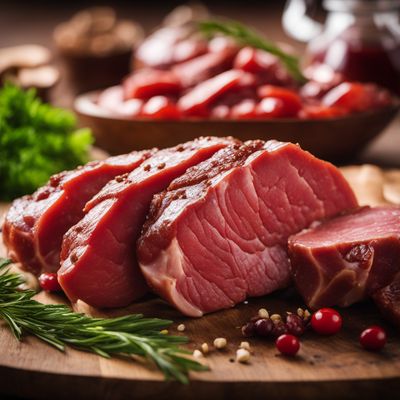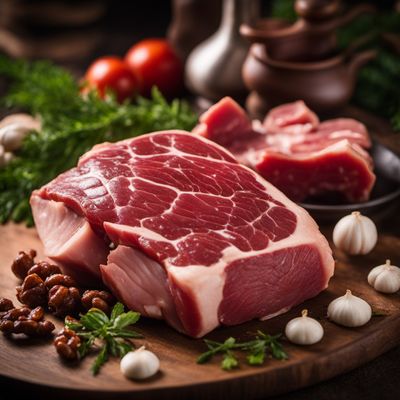
Ingredient
Roe deer meat
Delicate Delight: Roe Deer Meat
Roe deer meat is characterized by its lean and tender nature, making it a prized choice for meat lovers. It has a deep red color and a fine grain, with a subtle gamey flavor that is not overpowering. The meat is known for its tenderness, which lends itself well to quick cooking methods such as grilling or pan-searing.
Origins and history
Roe deer meat has a long history of being consumed in various cultures around the world. It has been a part of traditional European cuisine for centuries, particularly in countries like France, Germany, and Italy. Roe deer hunting has also been a popular activity in many regions, contributing to the availability of this meat.
Nutritional information
Roe deer meat is a good source of lean protein, essential vitamins, and minerals. It is lower in fat compared to other red meats, making it a healthier option. It provides nutrients such as iron, zinc, and B vitamins, which are important for overall health and well-being.
Allergens
Individuals with allergies to game meats should exercise caution when consuming roe deer meat, as it may trigger allergic reactions. It is recommended to consult with a healthcare professional if there are concerns about potential allergens.
How to select
When selecting roe deer meat, look for cuts that are fresh, firm, and free from any unpleasant odors. The meat should have a deep red color and minimal visible fat. If purchasing from a butcher, inquire about the source of the meat and ensure it comes from reputable suppliers who follow ethical and sustainable practices.
Storage recommendations
To maintain the freshness and quality of roe deer meat, it is best to store it in the refrigerator at temperatures below 40°F (4°C). If not consumed within a few days, it can be stored in the freezer for longer-term storage. Proper packaging, such as vacuum-sealed bags or airtight containers, can help prevent freezer burn and maintain the meat's flavor and texture.
How to produce
Roe deer can be raised in captivity for meat production, but it requires specialized knowledge and permits. It is not recommended for amateurs to attempt raising roe deer for meat at home. Instead, rely on professional suppliers who adhere to regulations and standards for ethical and sustainable meat production.
Preparation tips
Roe deer meat can be prepared using various cooking techniques, including grilling, pan-searing, roasting, or braising. It is important to avoid overcooking the meat to preserve its tenderness and prevent it from becoming tough. Marinating the meat prior to cooking can enhance its flavor and help tenderize it further. It pairs well with ingredients such as juniper berries, red wine, and root vegetables.
Culinary uses
Roe deer meat is commonly used in European cuisine, particularly in dishes that celebrate game meats. It can be used in stews, roasts, sausages, or even served as steaks. The meat's delicate flavor and tenderness make it a popular choice for gourmet preparations and fine dining establishments.
Availability
Roe deer meat is commonly available in regions where roe deer hunting is permitted, such as parts of Europe. It can be found in specialty butcher shops, game meat suppliers, or local markets. Availability may vary depending on hunting seasons and local regulations.
More ingredients from this category

European moose meat
The Majestic Delicacy: European Moose Meat Unveiled

Deer, red fresh meat
The Game-Changer: Red Deer Meat

Reindeer meat
The Arctic Delicacy

Deer, fallow fresh meat
The Delicate Delights of Fallow Deer Meat

Wapiti elk meat
The Majestic Delicacy: Wapiti Elk Meat

Deer, minced meat
Venison: The Lean and Flavorful Game Meat